
|
Back to |
| The Front Page |
| The Game |
|
A HISTORY OF GOLF CROQUET |
||||||||||||||||||
|
by Ray Hall, with thanks to Tony Hall, Amir Ramsis, and Osman El Hadary illustrations as credited Posted April 9, 2015
|
||||||||||||||||||
|
||||||||||||||||||
Although many have attempted it, England's Ray Hall was the first to come up with a surprisingly comprehensive history of the hottest thing to hit the sport of croquet since the Willis Setting. This online history is largely a direct adaptation of the pamphlet he published not long ago, but it also includes other elements not in the pamphlet: ancient rules; a chronology of the history and development of the game in Egypt, where it achieved its zenith in the early years of the 21st Century--until non-Egyptian champions learned to take on its original masters and win major championships: and additional photos and illustrations. The author and CROQUET WORLD acknowledge that there is still much to be discovered about this hugely important variant of the sport, and we invite further information from readers to be incorporated into new and improved editions of this history.
In the beginning
Though it has been suggested that Golf Croquet was invented as a practice game for Association Croquet, the reality is that it was invented, in the 1890s, as a garden party game. Initially it was promoted as a commercial enterprise and this still happens. The most recent version I have seen is labeled Crolf, using light mallets, small balls and four-pronged hoops. I have no doubt that there are many such; some are in the Bibliography (1).
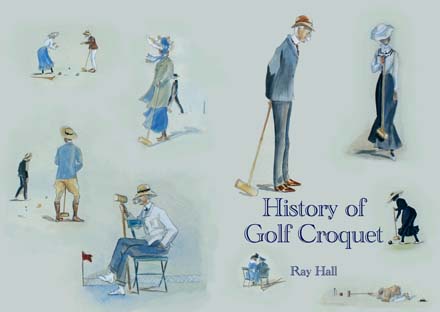
|
| This cover artwork is from a watercolour at The Sussex County Croquet Club (UK) signed and dated 1903, by Godfrey Brennan (1875-1948). |
| A HISTORY OF GOLF CROQUET |
|
Golf Croquet has been played for over 100 years, but there is no reference to GC in Prichard's, The History of Croquet, 1981 or in other sources. I knew that GC had been played at Dulwich from the 1920s, and found that other clubs had a similar history, and therefore wrote to the Gazette. Brian Dawes replied in reference to the Country Life piece quoted later on.
At the same time, Bob Kroeger wrote to the CA mailing list "A croquet friend has asked me if I know the history of golf croquet. I don't. Is there any online information on this?". The result was a flurry of interesting information from Stephen Mulliner, Liz Larsson, Chris Williams, et al. Later at the 2011 WCF GC World Championship at Hurlingham I was able to elicit more information (and, in two case, documents) from Amir Ramsis, Bill Arliss, Tony Hall and David Openshaw. Still not satisfied about the earliest reference to GC, I consulted bibliographical guru David Drazin who gave me some significant leads. He had donated his personal collection to the University of British Columbia in Vancouver, which was ironic, since I had recently played croquet near that library, but UBC had not catalogued David's collection so they could not help. Fortunately, the British Library and Cambridge University Library yielded some of the necessary material. Serendipity, that great aid to authorship, has also turned up a digital public domain copy of an early booklet otherwise buried in UBC Library. Though I cannot claim this booklet as definitive, there is much here which is unknown to most Golf Croquet players, and this seems a good way of sharing it. The outline of early development is fairly complete, notwithstanding a gap between 1901 and 1911, and there is certainly more to be said about the recent phases of the game. I hope, therefore, that others might build on this. I have worked from the above sources, without further acknowledgement, but I claim the errors as original, and will be glad to be told of them.
Ray Hall |
...though few gardens are not provided with an ordinary four-handed Lawn Tennis ground, it can be adapted to a lawn of almost any size and shape.The layout is given in the diagram on the next page. The aim is to play a single ball through each hoop hitting the relevant post as one goes, in as few strokes as possible.
The same game is introduced in The Graphic of 4 September 1897, thus:
Of late the parties given at the big houses in Dorsetshire and some of the adjoining counties have occasionally had among the amusements provided for guests the new game of "Croquet-golf" which has been thought out, brought into practical working and fully protected by patent and registration by Major-General R H Truell CB of Onslow near Wimborne.
A photograph in The Graphic, of an attractive party in Wimborne, is taken from the finishing end but is of too low resolution to reproduce here. The article goes on to proclaim an important matter for the hostess:
Croquet has become scientific and serious even to tediousness and lawn tennis is far too violent exercise for all but the most enthusiastic. It is claimed that the game is brisker and more energetic than the former and does not involve the flannels and exertion of the latter, while it shows off pretty gowns to advantage, promotes friendliness and even flirtation, and keeps people moving; all of which things the wise hostess regards as important.
Although The Graphic states that Major General Truell had patented and registered the game, I failed to find it from a search through the patent records. Ayres simply manufactured and sold the equipment.
A similar game is described in The Games of Lawn Hockey, Tether Ball, Squash Ball, Golf-Croquet (New York: American Sports Publishing Company, ca 1900). This came to light just after publication of The Bibliography (3) but I discovered a digital copy. This game evidently has golfing origins:
"Golf-Croquet is designed to utilize the favorite strokes of drives in golf, but on a moderate sized lawn. The controlling features of the game are: First-A good estimation of distance and force required to cover that distance. Second-Accuracy in driving a ball over the grass or lifting it through the air to clear obstacles."
The game is described for an irregular garden lawn (evidently New York lacked ordinary four-handed Lawn Tennis grounds) but the playing diagram is similar to the one below.
The course on any lawn or field depends on the shape of the place, and is marked, first, by wickets or arches, similar to those used in croquet, and second, by numbered flags. ... the wickets..must face [the] centre, as all shots made through wickets are towards the centre....
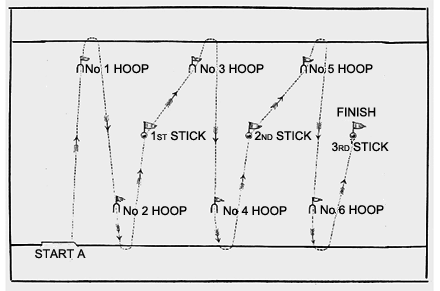
|
and, as for the equipment:
The mallets designed for the game are different from the croquet mallets, having longer handles and a bevel so arranged on one end of the mallet that it will lift the ball clear of the turf, and drive it in the direction of the prolongation of the axis of the mallet head.... The balls used are of wood, 2 inches in diameter, light and tough, the object being to get force and speed without much momentum and to be sure that they will float.
In the following year a different game, still named Croquet-Golf, is described in Country Life (4). It starts in a similar manner to The Graphic:
Some good genius, bored, as we may imagine without difficulty, by the scientific length and monotony of modern croquet, has invented a modification of the game, called croquet-golf, that is amusing enough and has merits as a pastime which croquet has not. It is not, to be sure, a classical game. It is a modern hybrid, but it passes the summer hours away without the vexation of spirit that has been known to attend croquet and is not unheard of at golf.
Thereafter, it is totally recognisable as Golf-Croquet, even to the extent of introducing a precursor of the half-way law:
... if blue were in the jaws of the hoop for which it was bound, and yellow, whose turn it was to play, had no chance of knocking blue from this position, then obviously it would be yellow's best plan to get position for the next hoop, giving up this one as hopeless. But these stratagems are distinctly forbidden, as tending to introduce an element that is "not golf" into the game.
The layout was the standard AC layout of the day, though the start was in the centre of the court, since it was necessary to hit the starting peg (the standard AC start was one foot in front of hoop one till 1905). What we do not know is whether this is an obvious adaptation of the Ayres game to the shape and layout of the croquet lawn, with a change of name, or whether there was some other, as yet undiscovered, inventor.
Development and consolidation
Early references in The Croquet Association Gazette are in advertisements and brief reports of informal events held at official tournaments in 1912. The game seems to have achieved instant popularity, and was played according to rules compiled by Robert Leetham Jones (5), Mr JEH Lomas (6) and "Professor C-S"(7), who were widely recognised as authorities on the tactics of the game.
But who exactly invented the game, and how, or when, the name changed from croquet-golf are still unclear. The name had definitely changed by 1913, when Horace Crowther Smith (8) produced How to win at Golf Croquet (A126). It is quite a small book, and much of the space taken up by variant court sizes and layouts. All the same, it constitutes a perfectly good introduction to the nature and tactics of the game as we know it. Of particular interest, in view of later development, is Crowther Smith's view of the jump-shot, which he regards as one of the more exciting procedures, and he inveighed against club secretaries who prohibited it as likely to damage the lawn.
One wonders who had been playing in the preceding twelve years to develop tactics, and provide a market for this sort of book, but there must have been many who felt the game had competitive possibilities.
The 1930s and official laws
In 1932 Crowther Smith published a much larger volume The Art of Croquet (A150), and in 1936 a further volume The Art of Golf Croquet (A153), still relatively slim. This implies that there must have been further interest, no doubt in clubs rather than country houses.
In addition to manufacture and sale of croquet and sports equipment, generally, F H Ayres was a keen croquet player (9). In 1933 he proposed to the CA Council that the GC rules be standardised. The Council were unanimously of the opinion that they should accept responsibility for standardizing the game. This task was referred to the Laws Committee under its chairman Sir Francis Colchester-Wemyss(10). The draft considered by the Laws Committee was prepared by Godfrey Turner (11). In December 1933 the CA Council approved new GC laws and so they were printed in the 1934 Directory, and continued to be printed with the laws until after 1998.
The laws, as thus printed (12), consist of only two pages plus a third dealing with handicaps. Most paragraphs were written explicitly as modifications of the AC laws, and differ from the current laws in that they prohibit the jump-shot, require the ball to run a hoop in a single pass (i.e. no jawsing); and have only a primitive version of the half-way law.
Egypt and modern developments
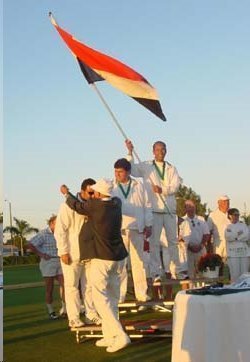
|
| Tony Hall awards trophies in the last light of day to the top three players in the 2002 world championship in Florida, while three-time winner Khaled Younis holds aloft the Egyptian flag. |
Egypt is of unique interest, since GC is known to have been played in "rest-houses" of the irrigation authority, public works and public health administrations, as well as those of Banks and cotton ginning mills. It also existed in the courtyards of prominent British officials where games were played amongst family members and friends.
The Gazette of 14 April 1921 describes an AC tournament held in March 1921 at the Al-Guezira (13) Sporting Club in Cairo, states that it was the first tournament since 1914, and that the Club now had six lawns.
In the Thirties GC was introduced into schools and clubs. The game at that time was played as now (with Willis setting) except that, in case of a 6/6 draw, the peg would be contested rather than hoop 13. Matters developed more quickly after 1952 when most foreign nationals left the country, so that Egyptian nationals increasingly took to the sport. Croquet equipment was manufactured locally, and AC appears to have been dropped.
The Egyptians developed the game (known just as "Croquet") more competitively than elsewhere. There were expert, athletic players, competing vigorously, and bookmakers accepted betting on games between the best players.
This was largely unreported in the UK, other than a mention in 1989 by Geoff Roy, a croquet playing BA pilot who, on a rest day, had been to the Gezirah Club and saw GC being played. However, in 1995 Chris Hudson, then Secretary-General of the World Croquet Federation, was invited by the Egyptian Croquet Association to visit Cairo to teach them Association Croquet. He saw how well they played Golf Croquet and concluded that something should be done about a World Championship.
Thus, in 1996 Chris Hudson organised a WCF Golf Croquet World Championship in Milan, using the existing CA laws. This first World Championship was a great success; the Egyptians dominated, with Khaled Younis winning from Hisham Abousbaa. A players' meeting agreed that the next championships should be in 1997 in Egypt using Egyptian rules. This, too, was dominated by the Egyptians and a Golf Croquet Working Party was commissioned to translate the Egyptian rules into English.
The next championship was held in England (Leamington Spa) in October 1998 and the second edition of the WCF Rules of Golf Croquet, allowing jump shots, was published in time for the fourth World Championships, held in Cairo in 2000. A new edition of the WCF Rules of Golf Croquet was published in 2005 for the first Women's World Championship (Cairo) and formed the basis of a complete change for the CA. The CA third edition (2008 with gold cover) was a result of further discussion through the WCF and was used in the 2009 WCF World Championship held in the UK. Now the 4th edition (2014, green) of the WCF rules has adopted the WCF "rules" terminology.
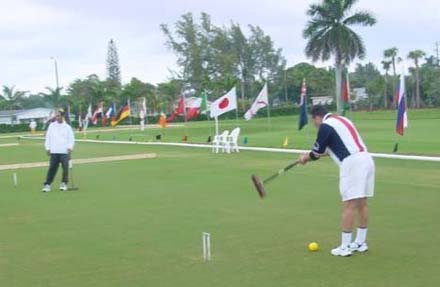
|
| The Golf Croquet World Championship first came to America in February of 2002, when all the best players were Egyptians, who captured the all three top trophies. Here's Khaled Younis (left) and Mohammed Kamal. |
The WCF has also organised a Women's World Championship (from 2005), Under 21 World Championship (2009), and over-50 World Championship (2010). Additionally, a European championship has been competed since 1999.
WCF world championships have been held on a roughly semi-annual basis in each of the major Golf Croquet playing countries at least once, including South Africa. A Golf Croquet World Teams event in three divisions has also begun. The WCF Ten-Year Calendar shows that all these events are intended to be regularly scheduled throughout the world.
In the year 2011, a non-Egyptian first captured the world championship. Mark MacInerney of Ireland made that breakthrough, and he was followed in 2013 by Reg Bamford, croquet's first "double champion" in both Association Croquet and Golf Croquet. In 2015, however, Ahmed Mahdi regained the title for Egypt.
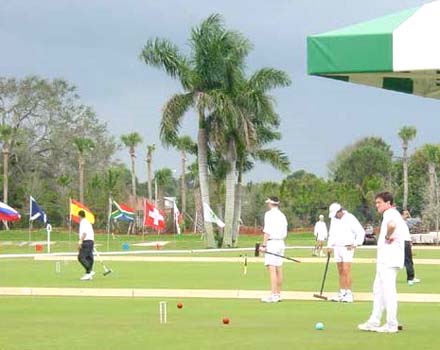
|
| Because of the hard-hitting style of top Golf Croquet players, boundary barriers are needed. These wooden barriers were the first of any kind used in America, at the National Croquet Center in West Palm Beach. Since then, much lighter round black irrigation pipes preferred as boundary stops. |
In the same period, non-Egyptian women broke through to world championship status, first the Australian Alix Verge, then the Englishwoman Rachel Rowe, and most recently the South African Judith Hanekom in 2014.
While both Egyptian men and women continue to crowd the top of the world rankings, Amir Ramsis, president of the both the Egyptian Federation and the World Croquet Federation, has observed that the achievement of so many non-Egyptian champions around the world is a significant milestone for both the game of Golf Croquet and the sport.
As of April 2015, it's clear that Golf Croquet has become a major and expanding part of the overall sport in every member country of the World Croquet Federation.
|
HISTORY & DEVELOPMENT OF GOLF CROQUET IN EGYPT
by Amir Ramsis, with thanks to General Osman El Hadary Golf Croquet was first introduced in Egypt through British colonialism. It was spread in guest houses and private properties belonging to prominent British officials; it was then introduced to clubs. During the Twenties (1920-1929) the sport existed in guest houses of the irrigation authority, public works and public health administrations, as well as those of banks and cotton ginning mills. It also existed in the courtyards of prominent British officials, where games were played amongst family members and friends. In the Thirties (1930-1939), the sport was introduced into schools and clubs. There was a croquet court - made of compressed sand - at the "Al-Raml Primary School" in Alexandria, in 1932, located at the Bakos area. The game was, at that time, played the same as it is nowadays except that, in case of a 6/6 draw, the center stake should be hit (instead of playing hoop No. 13, as we do now). The court's size, the distribution of hoops and center stake were the same as in the present. In the town of Zakazik, the sport was introduced at the sporting club there in the year 1935/1936, by the British manager of the Zakarik branch of Barclays Bank. In the Forties (1940-1949), the "Egyptian Pioneers of Golf Croquet" emerged in 1941, when some friends, namely General/ Mohamed Abdelhalim El-Daly (Chief Police Superintendent of Minya, at that time), Counselor/ Mohamed Sadek Fahmy (Head-Judge of the Minya Court) and Counselor/ Ahmed Esmat (Right-Judge of the Minya Court) noticed a deserted croquet court with incomplete playing tools. At their own expense, they restored the court ground and imported the playing tools from the "Lillywhites" store in London; thus, these three friends are credited for promoting the sport in the town of Minya, at a time when men only were allowed to play the game. In 1944, Counselor/ Mohamed Sadek Mahdy moved to the town of "Shebeen El-Kaum", where he introduced Golf Croquet. He started by having a piece of land reformed, at the Shebeen El-Kaum Club, and a playing court established. He then imported the necessary playing tools from England at his own expense. Counselor/ Ahmed Esmat also established a Croquet court, on his farm at "Mahallet Ellaban" village (Bassioon district), about 10 Kms from the town of Kafr El-Zayatt. General/ Abdelhalim Eh-Daly, as well, established a Croquet court at his house in "Maadi" (South of Cairo). In 1956, he also had part of the Bowling playing platforms (originally five Bowling courts established in 1930), of the Maadi Club converted into a Croquet court. Some players and fans were creating Croquet courts in their own courtyards. For instance, in 1946, Michel Avierino (owner, at that time, of the famous "Avierino" department store) built a grass croquet court at his house in Heliopolis, where games took place with guest families. In the Fifties (1950-1959) the sport spread to major clubs by the conversion of mini-golf and bowling courts into croquet playing grounds. As a consequence of the July 1952 revolution and the tripartite aggression in 1956, a majority of resident foreigners left the country, and thereafter the sport spread among Egyptians who populated the clubs the British and French left behind, and regular tournaments were organized between the clubs. In the early Fifties, croquet balls and mallets were purchased from local sport-shops, such as "Robert Hughes" at Kasr-El-Nil Street, in Cairo, who were importing them from England. However, in the late Fifties, mallets were being locally manufactured and, at that time, the price of a mallet was 1.5 Egyptian Pounds. In the Sixties (1960-1969), the sport spread further and the number of players grew considerably. Tournaments were organized between clubs, and trophies were offered by prominent personalities, such as the "Harkany Cup" offered by Mr. Naguib El-Harkany for games between Al-Guezira Club and the Alexandria Sporting Club, the "Ratl Cup" for games between Al-Guezira Club and Heliopolis Club and the "Dr. Ramadan Cup" offered by Dr. Mahmoud Ramadan for games between the Alexandria Sporting Club and Heliopolis Club. In the Sixties, the Egyptian manufacture of croquet balls was begun because of the shortage of foreign exchange currency, and they also manufacture their own hoops, which generally are heavier and sturdier than other hoops. In 1967, a great need was felt to establish a federation that would bring all clubs with croquet courts under one umbrella. This federation would also aim for legitimising the sport, raising its technical and administrative levels, and organizing tournaments between the clubs. On 16th of February, 1967, the Egyptian Croquet General Federation was established and registered to further support that purpose. |
|
Early Golf Croquet Rules
1. The ground shall be laid out as for croquet, except that the two centre hoops shall be placed so as to be played at right angles to, instead of in the alignment of, the sticks. 2. The players shall draw lots for choice of balls, blue and black belonging to one player, and red and yellow to the other. 3. The order of playing shall be as in croquet, viz.:- blue, red, black, yellow. The game shall commence from one stick not more than one mallet's length distant from it. 4. The object of the game is for a player to "make" the larger number of hoops and sticks in a round ; a hoop or stick is "made" when one of the player's balls goes through the former, or hits the latter, in proper order. 5. No player may play a ball on towards the next hoop or stick intentionally, until the one which is being played for has been "made." 6. If a player in the act of striking his ball hits or touches any other ball first, it shall be counted as a "foul," and his opponent shall have the option of replacing the balls moved, or not. A hoop or stick cannot be "made" off a "foul." 7. No player shall strike his ball until his opponent's ball has come to rest. 8. If a player plays his opponent's ball by mistake, it shall be left to the option of the opponent whether such a ball be brought back, or whether the opponent shall play the player's ball instead. |
FOOTNOTES:
1 CROQUET: A Bibliography 1999, edited by David Drazin
About the author:
Ray Hall discovered croquet in his 40s, getting to a decent, though not spectacular, handicap just before he was 50 at the Harrow Oak Club, where David Drazin also played. Progress was halted by a shoulder injury, but picked up again, with a new Club (Dulwich) and new grip (Solomon) ten years later. Having moved out of London he now plays at Sussex County (aka Southwick) and has refereed at the 2011 World GC Championship and the WCF 2014 AC team championship (division 2.2) as well as coaching and managing tournaments from time to time. His first croquet publication was a Centenary History of the Dulwich Croquet Club (2012) in the preparation of which he noted that GC was badly served by the historians. The present work is the initial result and hard copy of the first edition can be obtained from Southwick; readers can expect further findings soon in the English Croquet Gazette.
2 Thanks are due to Cambridge University Library for a copy of this rare document
3 Personal communication from David Drazin
4 24 August 1901 (and see preface)
5 b 1896, Barrister, editor of the Gazette, 1921-37
6 John Lomas 1868-1939. Mining engineer and entrepreneur, spent much time in Southern Africa; "redoubtable player" (The Bystander ,1905 ) who played in the Champion Cup 1910 though "unable to devote much time to the game "(Country Life 1910)
7 This 'professor' must be Horace Francis Crowther Smith. 1873-1959
8 Artist & wit; Editor of the Gazette 1937-54 (NB he was not hyphenated at birth)
9 The Ayres Cup was the trophy for the winner of the British Open Championship. This was replaced by the Coronation Cup in 1911, and the Ayres Cup is now presented to the runner-up.
10 1875-1954 Member of the Cheltenham Croquet Club, sometime president of CA, Chairman of the Laws Committee, and author of The Pleasures of the Table (1931)
11 1871-1952 a successful player 1919-1937
12 In fact, the first laws were more detailed and were truncated by the 1980s
13 Usually Gezirah in the UK, but transliterations vary